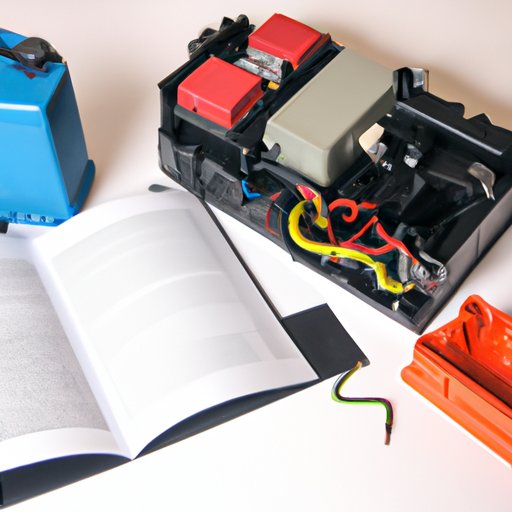Introduction
The starter is a crucial component of any car engine. It’s responsible for powering up the engine and getting it running. Without a working starter, your car won’t start. So, if you’re having trouble with your car starter, it’s important to get it fixed as soon as possible.
In this article, we’ll walk you through the steps of how to fix a car starter. We’ll explain what a car starter is and why it’s important to fix it. We’ll also cover how to consult a repair manual, check the battery, clean any corrosion, replace the starter solenoid, check the starter relay, test the starter motor, and test the ignition switch.
Consult a Repair Manual
The first step in fixing a car starter is to consult a repair manual. A repair manual is a book that contains detailed instructions on how to diagnose and repair different parts of a car. It will provide you with information on the specific make and model of your car, including wiring diagrams and part numbers.
You can find repair manuals at most auto parts stores or online. When buying a repair manual, make sure to get one that is specific to your car’s make and model. This will ensure that the instructions are accurate and up to date.
Check the Battery
Once you have your repair manual, the next step is to check the battery. If the battery is weak or failing, it won’t have enough power to start the engine. To check the battery, you should look for signs of corrosion or wear. Corrosion can be caused by dirt, grease, or moisture. Wear can be caused by age or overcharging.
You can also perform a voltage test to see if the battery is functioning properly. The voltage should read between 12.5 and 12.8 volts when the engine is off. If the voltage is lower than this, the battery may need to be replaced.
Clean Any Corrosion
If there is any corrosion on the battery terminals or cables, it needs to be cleaned off. Corrosion can keep the electrical current from flowing properly, preventing the car from starting. To clean off corrosion, use a wire brush and baking soda solution. Scrub the terminals and cables until they are free of corrosion.
Once the corrosion has been removed, you should apply a thin layer of petroleum jelly or dielectric grease to the terminals and cables. This will help prevent future corrosion.
Replace the Starter Solenoid
The starter solenoid is responsible for sending an electrical signal from the ignition switch to the starter motor. If the solenoid is faulty, it won’t be able to send the signal and the car won’t start. To determine if the solenoid is faulty, you can remove it and check for signs of wear or damage.
If the solenoid is faulty, you’ll need to replace it. You can buy a replacement solenoid at most auto parts stores. Once you’ve purchased the new solenoid, you can install it by following the instructions in your repair manual.
Check the Starter Relay
The starter relay is responsible for sending the electrical signal from the ignition switch to the starter solenoid. If the relay is faulty, it won’t be able to send the signal and the car won’t start. To check the starter relay, you can remove it and inspect it for signs of wear or damage.
If the relay is faulty, you’ll need to replace it. You can buy a replacement relay at most auto parts stores. Once you’ve purchased the new relay, you can install it by following the instructions in your repair manual.
Test the Starter Motor
The starter motor is responsible for turning the engine over and getting it running. If the motor is faulty, it won’t be able to turn the engine over and the car won’t start. To test the starter motor, you can use a multimeter to measure the voltage across the terminals.
If the voltage is too low, the motor may need to be replaced. You can buy a replacement starter motor at most auto parts stores. Once you’ve purchased the new motor, you can install it by following the instructions in your repair manual.
Test the Ignition Switch
The ignition switch is responsible for sending an electrical signal to the starter motor. If the switch is faulty, it won’t be able to send the signal and the car won’t start. To test the ignition switch, you can use a multimeter to measure the voltage across the terminals.
If the voltage is too low, the switch may need to be replaced. You can buy a replacement ignition switch at most auto parts stores. Once you’ve purchased the new switch, you can install it by following the instructions in your repair manual.
Conclusion
In this article, we’ve covered the steps of how to fix a car starter. We’ve explained what a car starter is and why it’s important to fix it. We’ve also covered how to consult a repair manual, check the battery, clean any corrosion, replace the starter solenoid, check the starter relay, test the starter motor, and test the ignition switch.
When working on a car starter, it’s important to take safety precautions. Make sure to wear safety glasses and gloves to protect yourself from any debris or chemicals. Also, make sure to disconnect the negative terminal of the battery before beginning any repairs.
(Note: Is this article not meeting your expectations? Do you have knowledge or insights to share? Unlock new opportunities and expand your reach by joining our authors team. Click Registration to join us and share your expertise with our readers.)
